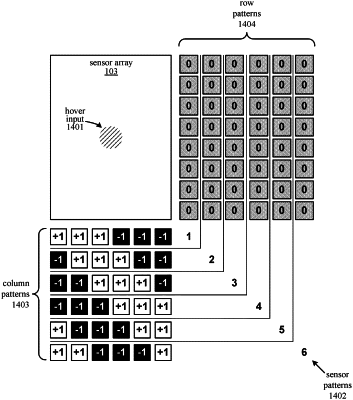| CPC G06F 3/044 (2013.01) [G06F 3/0416 (2013.01); G06F 3/04166 (2019.05); G06F 3/0446 (2019.05); G06F 2203/04108 (2013.01)] | 22 Claims |

|
1. A capacitance sensing device, comprising:
a transmit (TX) generator configured to generate a sequence of receive (RX) signals by applying each TX signal pattern in a sequence of TX signal patterns to a set of sensor electrodes, the set of sensor electrodes comprising all of the sensor electrodes coupled to the transmit generator, wherein for each TX signal pattern in the sequence of TX signal patterns, the TX generator is configured to apply excitation signals to the set of sensor electrodes by, for each subset of a plurality of subsets each including three or more contiguous sensor electrodes of the set of sensor electrodes, applying the same one of a first excitation signal and a second excitation signal to each of the three or more contiguous sensor electrodes in the subset, wherein a magnitude of a sum of the excitation signals applied to the set of sensor electrodes is less than a magnitude of any one of the excitation signals applied to the set of sensor electrodes, and wherein the plurality of subsets comprises at least half of the sensor electrodes in the set of sensor electrodes;
a sequencer circuit coupled with the TX generator and configured to, for each TX signal pattern in the sequence of TX signal patterns, determine a next subsequent TX signal pattern in the sequence based on a circular rotation of the TX signal pattern; and
a processing block coupled with the TX generator and configured to detect a presence of an object proximate to the set of sensor electrodes based on a measure of correlation between the sequence of RX signals and a predetermined function.
|